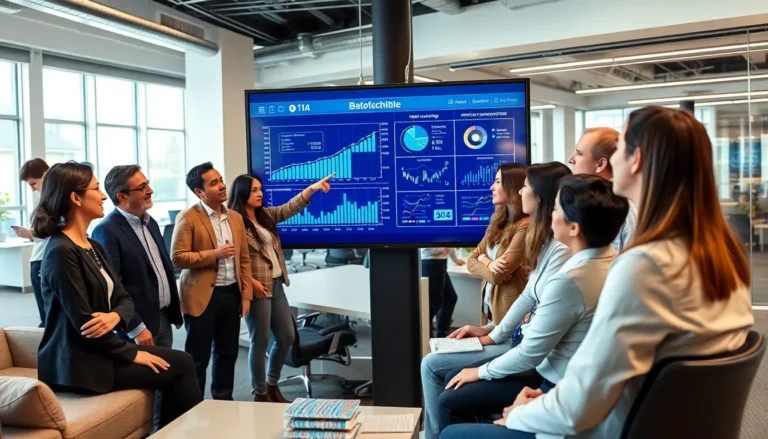Language processing technology is revolutionizing the way humans and machines communicate. Imagine a world where your smart assistant understands your quirky jokes and responds with a witty comeback. Sounds like a scene from a sci-fi movie, right? Yet, this technology is not just a figment of imagination; it’s reshaping industries and enhancing everyday interactions.
Table of Contents
ToggleOverview of Language Processing Technology
Language processing technology enables machines to comprehend, interpret, and respond to human language. This capability significantly enhances communication between humans and computers. Various applications arise from advancements in this field, including chatbots, virtual assistants, and real-time translation services.
Natural Language Processing, or NLP, stands at the forefront of these innovations. NLP systems analyze text data, allowing them to understand context, sentiment, and intent. Companies rely on NLP to enhance customer service by automating responses and personalizing user interactions.
Moreover, machine learning techniques propel advancements in language processing technology. Algorithms study vast datasets to improve accuracy in understanding and generating human language. As a result, systems become increasingly adept at recognizing nuances, idioms, and even humor.
In addition, speech recognition technology transforms spoken language into text. This application serves numerous industries, including healthcare and customer support. Hospitals utilize speech recognition to streamline documentation processes, reducing the administrative burden on medical staff.
Data from a recent report by MarketsandMarkets indicates that the global NLP market is projected to grow from $11.6 billion in 2020 to $43.8 billion by 2025. Such growth underscores the importance of these technologies across various sectors.
Overall, language processing technology is revolutionizing how individuals engage with machines. Increased understanding fosters more natural interactions and contributes to enhanced user experiences. As advancements continue, expect further integration of this technology into daily life.
Key Components of Language Processing Technology

Language processing technology consists of various essential components that enhance human-machine interactions. These critical components include Natural Language Processing and Speech Recognition Systems.
Natural Language Processing
Natural Language Processing (NLP) enables machines to understand and interpret human language. Through sentiment analysis, NLP identifies emotional tone and context within textual data. Users benefit from automated responses, as systems can discern intent accurately. By employing machine learning algorithms, NLP continually evolves, increasing its effectiveness. A report reveals that the global NLP market is set to rise from $11.6 billion in 2020 to $43.8 billion by 2025, reflecting its growing significance. Organizations increasingly rely on NLP to personalize customer interactions, allowing for more meaningful engagements.
Speech Recognition Systems
Speech recognition systems convert spoken language into text, playing a pivotal role in language processing technology. These systems utilize advanced algorithms to recognize voice patterns and transcribe audio accurately. Industries such as healthcare and customer support reap the rewards of efficient and accurate transcription. Real-time speech recognition enhances accessibility, allowing individuals with disabilities to interact seamlessly. As technology advances, these systems achieve higher accuracy rates, improving user experiences significantly. Wider adoption of speech recognition leads to more applications across sectors, underscoring its importance in everyday technology use.
Applications of Language Processing Technology
Language processing technology plays a critical role in various sectors, enhancing communication and efficiency. Key applications include chatbots, virtual assistants, content creation, and real-time translation.
Chatbots and Virtual Assistants
Chatbots serve as automated conversational agents, offering instant support to customers. Companies implement these tools to handle inquiries, improving response times and customer satisfaction. Virtual assistants like Siri or Alexa utilize natural language processing to perform tasks, including setting reminders or playing music. These systems analyze user requests, allowing for more personalized interactions. As machine learning algorithms further develop, chatbots and virtual assistants adapt better to individual user preferences, creating tailored experiences.
Content Creation and Translation
Language processing technology streamlines content creation, making it faster and more efficient. Businesses leverage these tools to generate marketing copy, social media posts, and other written content. Automated translation services break down language barriers, enabling seamless global communication. Tools like Google Translate utilize NLP to provide real-time translations, enhancing accessibility for diverse audiences. The advanced algorithms driving these applications significantly improve accuracy, making communication clearer and more effective.
Challenges in Language Processing Technology
Language processing technology faces several challenges that impact its effectiveness and user adoption. Two prominent issues include ambiguity and context understanding, as well as data privacy concerns.
Ambiguity and Context Understanding
Ambiguity in language presents a significant hurdle for language processing systems. Natural language often contains words and phrases with multiple meanings. This ambiguity can confuse machines trying to grasp user intent. Context plays a crucial role in deciphering meaning. Without adequate context, responses may not align with the user’s expectation. Understanding slang, idioms, or regional dialects further complicates matters. Achieving accuracy requires ongoing advancements in algorithms and data sets. Enhanced training data improves a system’s capability to discern nuance in language.
Data Privacy Concerns
Data privacy concerns hinder wider adoption of language processing technology. Users express apprehension regarding personal data being processed and stored. Compliance with regulations, like GDPR, becomes essential for organizations utilizing these technologies. Companies must ensure that data collection practices are transparent and secure. Addressing these concerns fosters user trust, encouraging businesses to implement language processing solutions. Encryption and anonymization techniques can protect sensitive information. Prioritizing data privacy enables a balance between technological advancement and consumer protection, promoting responsible use in various applications.
Future Trends in Language Processing Technology
Advancements in language processing technology promise to redefine communication between humans and machines. The integration of artificial intelligence will enhance the ability of machines to understand context, allowing for more meaningful exchanges. Researchers focus on developing models that grasp humor and cultural nuance, fostering more natural interactions.
Increased investment in deep learning techniques will drive accuracy improvements in natural language processing. With the global NLP market projected to grow from $11.6 billion in 2020 to $43.8 billion by 2025, companies prioritize AI-powered solutions to enhance customer experiences. Businesses adopt chatbots and virtual assistants for personalized support, leading to higher customer satisfaction.
Real-time translation capabilities will expand greatly, breaking down language barriers in global communication. As automated translation services evolve, they will incorporate slang and idioms, improving comprehension for diverse audiences. This will be crucial for international businesses aiming to connect with clients across linguistic boundaries.
Enhanced speech recognition systems also represent a significant future trend. Development in these technologies will facilitate seamless integration with homes and workplaces, automating tasks through voice commands. As accuracy rates improve, speech-to-text applications will gain favor in healthcare and customer support settings.
Data privacy remains a critical consideration as language processing technology advances. Organizations must implement transparent practices to foster user trust while complying with regulations like GDPR. Balancing innovation with ethical considerations will be vital for the sustainable growth of language processing technologies.
Language processing technology is reshaping communication between humans and machines. As advancements continue to unfold the potential for more natural interactions grows. With applications spanning from chatbots to real-time translation services the impact is evident across various industries.
The future promises even greater integration of AI and deep learning techniques enhancing contextual understanding and user experiences. However the importance of data privacy and ethical considerations cannot be overlooked. Balancing innovation with responsible practices will be crucial for fostering trust and ensuring sustainable growth in this dynamic field. As language processing technology evolves it will undoubtedly play a pivotal role in shaping how individuals connect with the digital world.




